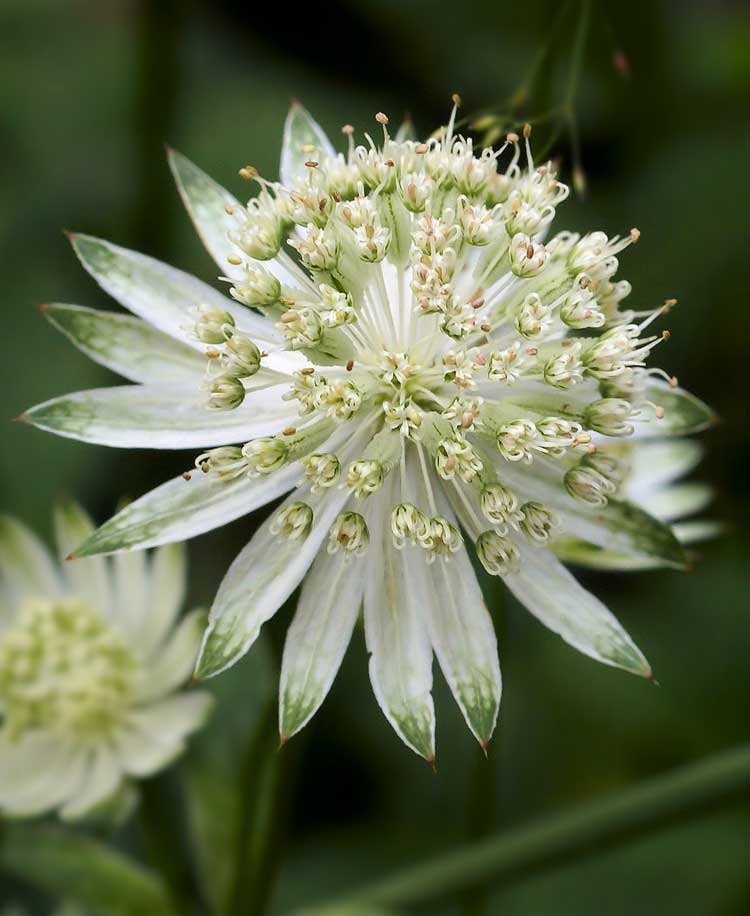
Astrantia major (*)
Classification System: APG IV
Superregnum: Eukaryota
Regnum: Plantae
Cladus: Angiosperms
Cladus: Eudicots
Cladus: Core eudicots
Cladus: Asterids
Cladus: Campanulids
Ordo: Apiales
Familia: Apiaceae
Subfamilia: Saniculoideae
Tribus: Saniculeae
Genus: Astrantia
Sectio: A. sect. Astrantia
Species: Astrantia major
Subspecies: A. m. subsp. biebersteinii – A. m. subsp. elatior – A. m. subsp. involucrata – A. m. subsp. major
Varietates: A. m. var. apenninica – A. m. var. pyrenaica
Name
Astrantia major L., Sp. Pl. 1: 235. 1753.
Typus: Linnaean Herbarium 334.1 (LINN). Lectotype, designated by Reduron & Jarvis, Regnum Veg. 127: 22. 1993.
References
Linnaeus, C. 1753. Species Plantarum. Tomus I: 235. Reference page.
Links
Hassler, M. 2018. Astrantia major. World Plants: Synonymic Checklists of the Vascular Plants of the World In: Roskovh, Y., Abucay, L., Orrell, T., Nicolson, D., Bailly, N., Kirk, P., Bourgoin, T., DeWalt, R.E., Decock, W., De Wever, A., Nieukerken, E. van, Zarucchi, J. & Penev, L., eds. 2018. Species 2000 & ITIS Catalogue of Life. Published online. Accessed: 2018 Sept. 15. Reference page.
International Plant Names Index. 2018. Astrantia major. Published online. Accessed: Sept. 15 2018.
The Plant List 2013. Astrantia major in The Plant List Version 1.1. Published online. Accessed: 2018 Sept. 15.
Tropicos.org 2018. Astrantia major. Missouri Botanical Garden. Published online. Accessed: 15 Sept. 2018.
USDA, ARS, Germplasm Resources Information Network. Astrantia major in the Germplasm Resources Information Network (GRIN), U.S. Department of Agriculture Agricultural Research Service. Accessed: 07-Oct-06.
Vernacular names
беларуская: Астранцыя вялікая
čeština: jarmanka větší, jarmanka
Cymraeg: Astrantia
dansk: Stor Stjerneskærm
Deutsch: Große Sterndolde, Schwarzer Sanikel, Sternblume
English: great masterwort, astrantia, greater masterwort
español: Sanicula hembra
suomi: Isotähtiputki
français: grande astrance, grande radiaire
hornjoserbsce: Wulki bělan
magyar: Nagy völgycsillag
italiano: astranzia maggiore
ქართული: ვარსკვლავა
lietuvių: Didžioji astrantija
Nederlands: Zeeuws Knoopje, Groot Sterrenscherm
polski: Jarzmianka większa
Piemontèis: Astrantia major
русский: Астранция крупная, Астранция большая
slovenčina: jarmanka väčšia
svenska: Stjärnflocka, Linnés fröknar, Linnes fröknar
українська: Астранція велика, Напрасниця, Гоюче зілля
Astrantia major, the great masterwort, is a species of flowering plant in the family Apiaceae, native to central and eastern Europe. Growing to 90 cm (35 in) tall by 45 cm (18 in) broad, it is an herbaceous perennial, much used in gardens.
Etymology
The Latin specific epithet major, meaning "larger", distinguishes this species from its smaller relative Astrantia minor.[1]
Description
Astrantia major reaches on average 60 centimetres (24 in) of height. The stem is erect and glabrous, with little branches and few leaves. The basal leaves have a long petiole 10–20 centimetres (3.9–7.9 in), 3 to 7 lobes and toothed segments. Size: 8–15 centimetres (3.1–5.9 in). The cauline leaves are generally two, sessile, amplexicaul and lanceolate-shaped with a trilobed apex. The inflorescence is umbrella-shaped, with 2–3 centimetres (0.79–1.18 in) of diameter. The floral bracts are numerous (10 - 20), 10–18 millimetres (0.39–0.71 in) long, reddish (sometimes white) with acuminate apex. The small flowers are greenish-white with reddish shades. The central ones are hermaphrodite, while the external ones are male. The petals are five, white (or slightly reddened), while the stamens are five and much longer. Size of the flowers: about 1 mm. The flowering period extends from June through September.
Biochemistry
The plant also produces an essential oil[2] that can be used in herbal medicines.[3]
Reproduction
Astrantia major is an entomophilous plant, mainly pollinated by beetles, but also by other insects. This perennial plant reproduces itself also by means of buds present at the ground level.
Distribution
This plant is native to southern Europe (the Pyrenees, Carpathians and Balkans), but also in the Caucasus up to Anatolia. It has been in the British Isles since the 16th century. It has also naturalized in Shropshire near Stokesay Castle,[4] and in Worcestershire.[5]
It is common in mountain meadows and grasslands, in forests and clearings, and close to the streams, usually on calcareous soils, at an elevation of 100–2,300 metres (330–7,550 ft) above sea level.
Subspecies
Astrantia major L. subsp. carinthiaca (Hoppe) Arcang. : Larger umbels (4–5 cm in diameter) widespread mainly in the eastern Alps.
Astrantia major var. involucrata Koch
Astrantia major L. subsp. elatior (Frivaldsky) Maly: bracts with 5 nerves and with notched apex; teeth of the calyx are very long; widespread in the Apennines.
Astrantia caucasica Auct. Fl.Ital non Sprengel
Astrantia major L. subsp. major
Astrantia major subsp. biebersteinii (Fisch. & C.A.Mey.) I.Grint. (with synonyms of Astrantia biebersteinii Fisch. & C.A.Mey.,Astrantia colchica Albov, Astrantia intermedia Bieb., Astrantia neglecta C.Koch & Bouche, Astrantia orientalis Woronow, Astrantia ossica Woronow and Astrantia trifida Hoffm. [6])
Cultivation
Many strains of Astrantia major grow well in the garden, given some shade and moisture. Their flowerheads provide summer colour in shades of red, pink and white. The following cultivars have gained the Royal Horticultural Society's Award of Garden Merit:-
A. major 'Roma'[7]
'Sunningdale Variegated'[8]
Other cultivars include:-
'Abbey Road'
'Ruby Cloud'
'Rubra'
'Snow Star'
'Lars'
'Moulin Rouge'
'Star of Heaven'
'Rosea'
'Princess Sturdza'
'Venice'
'Magnum Blush'
'Star of Beauty'
'Vanilla Gorilla'
'Roma'
'Hadspen Blood' (a hybrid crossed with Astrantia maxima)[9]
'Shaggy' (previously 'Margey Fish')[9]
Gallery
Apiaceae - Astrantia major-2.JPG
Astrantia major ENBLA01.jpg
A. major 'Star of Beauty'
A. major 'Star of Beauty'
Leaf
Leaf
References
Harrison, Lorraine (2012). RHS Latin for gardeners. United Kingdom: Mitchell Beazley. p. 224. ISBN 9781845337315.
Radulović, N.S.; Mladenović, M.Z.; Ethorđević, N.D. (July 2012). "Chemotypification of Astrantia major L. (Apiaceae): essential-oil and lignan profiles of fruits". Chemistry & Biodiversity. 9 (7): 1320–37. doi:10.1002/cbdv.201100430. PMID 22782878. S2CID 32907219.
Panda, H. Handbook on Medicinal Herbs with Uses, p. 163, at Google Books
Lloyd, Christopher (1967). Hardy Perennials. Letchworth: Garden City Press. p. 67.
Margery Fish Garden Flowers&pg=PA46 1R2_CAAAQBAJ, p. 46, at Google Books
"Catalogue of Life : Astrantia trifida Hoffm". www.catalogueoflife.org. Retrieved 26 April 2020.
"RHS Plant Selector - Astrantia major 'Roma'". Retrieved 15 April 2020.
"RHS Plant Selector - Astrantia major 'Sunningdale Variegated'". Retrieved 15 April 2020.
The Horticulture Gardener's Guides - Perennials. p. 2.
Retrieved from "http://en.wikipedia.org/"
All text is available under the terms of the GNU Free Documentation License

